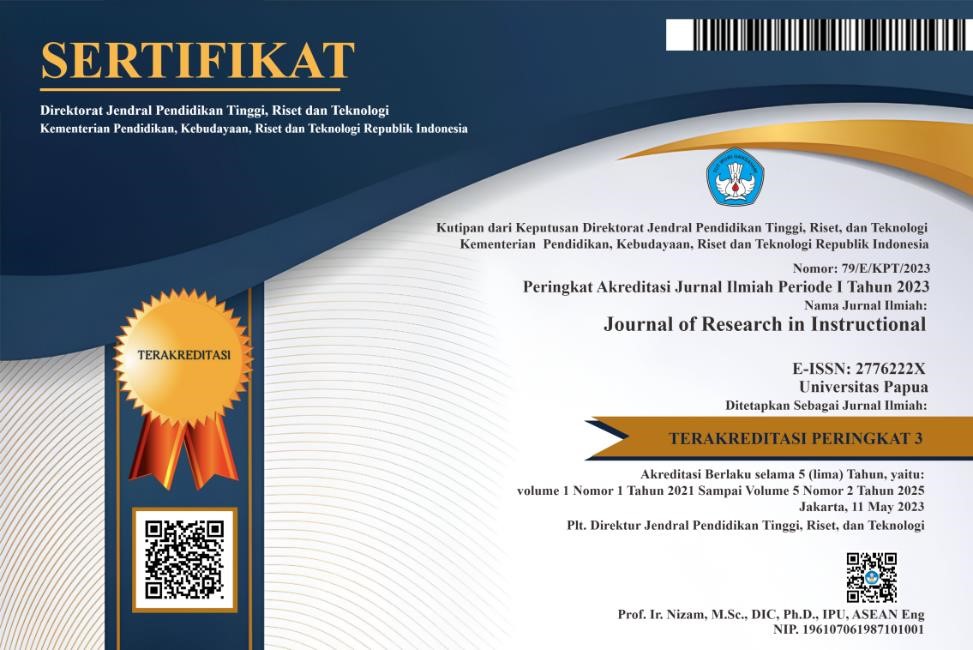Development and evaluation of an instructional LiveBinders for learning selected computer studies concept in Ilorin Metropolis
DOI:
https://doi.org/10.30862/jri.v1i2.13Keywords:
LiveBinders, concretize learning, interest, evaluationAbstract
This research was developed and evaluated an instructional LiveBinders for learning selected computer Studies concepts in Ilorin Metropolis, Nigeria. In this research, the design and development model was used. The participants in the study were five computer studies teachers, five computer science experts, and five educational technology experts were chosen at random. The following research instruments were used in this study: a developed computer storage device for computer studies, an expert rating guide of educational technology, and a subject content validation questionnaire. Research questions were answered using percentages and mean. The study concluded that if LiveBinders are properly integrated into learning, computer studies learning can be improved. As a result, it was suggested that students be encouraged to use LiveBinders for learning regardless of a subject area.
References
Adamu, S .H & Bello, A. (2012). Computer education in Nigeria school. Nigeria journal of computer literarcy, 2(4), 96-102.
Adeosun, O. (2010). Quality basic education development in Nigeria. Journal of International Cooperation in Education, 2(2), 193-211.
Aladesusi G. A., Nifemi, A. O., & Omolara, O. T. (2022). Development and evaluation of lessoncast in learning selected basic technology concept in Ilorin Metropolis. Indonesian Journal of Educational Research and Technology, 2(1), 21-36.
Aminu, N., Hamdan, M., & Russell, C. (2021). Accuracy of self-evaluation in a peer-learning environment: An analysis of a group learning model. SN Social Sciences, 1(7), 1-17.
Bamidele, S. O. (2006). Development of modern ICT and internet system. Information and comunication technology and computer applications, 2(1). 1-3.
Becta. (2014). What the research says about using ICT. Journal of technology Education 3(2),1-9.
Carver, L., & Pantoja, L. (2021). Visual and Auditory Production. In L. Carver & H. S. Atkins (eds.), Leading in the Digital Environment: Being a Change Agent. Rowman & Littlefield.
Crosby, M. E., & Stelovsky, J. (1995). From multimedia instruction to multimedia evaluation. Journal of Educational Multimedia and Hypermedia, 4, 147-162.
Dick, Carey & Carey. (2005). The Systematic Design of Instruction. Pearson/Allyn and Bacon
Eick, C. J., & King Jr, D. T. (2012). Nonscience Majors' Perceptions on the Use of YouTube Video to Support Learning in an Integrated Science Lecture. Journal of College Science Teaching, 42(1).
Empirica. (2016). Benchmarking access and use of ICT in school. Report from head Teacher and Classroom 7(2),11-21.
Fink, L. D. (2013). Creating significant learning experiences: An integrated approach to designing college courses. John Wiley & Sons.
Fisher. (2012). Information resourse. Journal on livebinder, 2(1),1-3.
Jung, I. (2005). ICT-pedagogy integration in teacher training: Application cases worldwide. Journal of Educational Technology & Society, 8(2), 94-101.
Kiptalam, G. K., & Rodrigues, A. J. (2010). Accessibility and utilization of ICTs among secondary school teachers in Kenya. The International Conference on Computing and ICT Research, 246–263.
Little, M., Cohen-Vogel, L., Sadler, J., & Merrill, B. (2020). Moving kindergarten entry assessments from policy to practice evidence from North Carolina. Early Education and Development, 31(5), 796–815. https://doi.org/10.1080/10409289.2020.1724600
Mason, L. L, & Andrews, A. (2014). Referent-Based Verbal Behavior Instruction for Children with Autism. Behavior Analysis in Practice, 7(2), 107–111. https://doi.org/10.1007/s40617-014-0018-z
Merry-Perry, M. J. M. (2013). Effects of visual media on achievement and attitude in a secondary biology classroom. A Master’s Research Project Presented to The Faculty of the Patton College of Education and Human Services Ohio University.
Mpungose, C. B. (2020). Are Social Media Sites a Platform for Formal or Informal learning? Students’ Experiences in Institutions of Higher Education. International Journal of Higher Education, 9(5), 300. https://doi.org/10.5430/ijhe.v9n5p300
OECD. (2017). Panorama da la education. information commucation and technology in education , 4(1),13-22.
Ogunode, N. J., Hammadu, M., Ahmed, I., & Ojo, I. C. (2021). Challenges Preventing Students in Public Tertiary Institutions from Using Information Communication Technology for Learning in Nigeria and the Way Forward. Pindus Journal of Culture, Literature, and ELT, 9, 9-17.
Okenwa. (2008). Meetting the challenges of information technology. case for reform in distance education programme, (pp. 197-202). Nsukka.
Oshinaike & Adekunmisi. (2017). Use of multimedia for teaching in Nigerian. a case study of University of Ibadan. Library Philosophy and Practice , 9(2), 13-15.
Oyebola. (2018). National development on ict. ICT , 2(1), 1-3.
Raiman, M., Liu, A. N. A. M., & Wolo, D. (2021). Investigation of students’ motivation to learn science while studying from home during a pandemic. Journal of Research in Instructional, 1(1), 33–42. https://doi.org/10.30862/jri.v1i1.10
Ratheeswari, K. (2018). Information communication Technology. Journal of Applied and Advance Research 2(6), 9-12 .
Richey & Klein. (2007). Developmental research: Studies of instructional design and development. Handbook of research for educational communication and technology, 6(1), 1099-1130.
Shan & Khan. (2015). strategies on teaching. integration Of Information And Communication Technology, 5(1), 2-4.
Sidi. (2015). Human right in general and womens right. Gender Access to ICT, 2(4), 1-4.
Spicher, N., Barakat, R., Wang, J., Haghi, M., Jagieniak, J., Öktem, G. S., Hackel, S., & Deserno, T. M. (2021). Proposing an international standard accident number for interconnecting information and communication technology systems of the rescue chain. Methods of Information in Medicine, 60(S-01), 20–e1. https://doi.org/10.1055/s-0041-1728676
Sukhendu. (2018). Principle of learning. LiveBinder, 5(2),1-3.
Tamara. (2012). Resourses for various educational purposes. journal on livebinder , 1-3.
UNESCO. (2014). Information and communication technology in education. A comparative analysis of ICT integration in school, 4(3), 11-22.
Uslu, O., & Bumen, N. T. (2012). Effects of the professional development program on Turkish teachers: Technology integration along with attitude towards ICT in education. Turkish Online Journal of Educational Technology-TOJET, 11(3), 115–127.
Downloads
Published
Issue
Section
License
Copyright (c) 2021 Gboyega Ayodeji Aladesusi, Fatai Oloruntobi Akindiya

This work is licensed under a Creative Commons Attribution-ShareAlike 4.0 International License.






